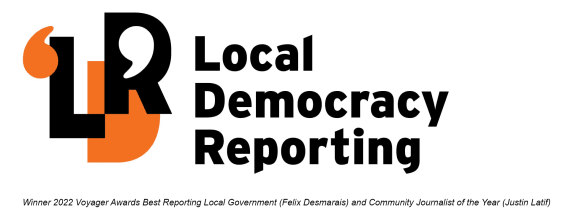
Regional Development and Emergency Management Minister Kieran McAnulty says redevelopment of Whanganui Port will build essential resilience for the region. Photo: LDR / Moana Ellis
Regional Development and Emergency Management Minister Kieran McAnulty says the redevelopment of Whanganui Port sets the scene for continued economic growth and will build vital resilience for the region.
The minister was in Whanganui on Wednesday to break ground and mark the start of construction on Te Pūwaha Stage One Port civil construction works for the $62.85 million port rebuild.
He said the port project would establish a modern marine precinct and support “considerable growth potential” for boat building and repairs – and jobs to match.
“It aims to support the expansion of local businesses and increasing freight demands in the Whanganui region,” McAnulty said.

Stage One works include building a heavy pavement vessel hardstand and concrete structures out over the Whanganui River, capable of carrying Q-West Boat Builder’s 380-tonne capacity mobile boat hoist.
A specialist water treatment plant to service the vessel maintenance heavy pavement will also be built.
The wider project includes rebuilding existing wharves, demolishing derelict structures and staged dredging of the port basin.
The minister said the new port would provide the district with resilience in any emergency management situation. It would also improve waterway integrity to support the port at the mouth and lower reach of the river.
“Having a resilient port is essential in emergency management, not only in the initial response but also in recovery,” McAnulty said.
“When completed, this project will ensure protection from erosion, sea encroachment and provide resilience to further sea-level rise.”
The government has invested $31.8m in the new port through the Provincial Growth Fund and Kānoa Regional Economic Development & Investment Unit.
McAnulty said the growth was a reflection of the collaborative Te Pūwaha model and its commitment to staying true to the long-term values of Te Awa Tupua.
“And Te Pūwaha goes a step further by matching skills and training to this growth.”
Te Pūwaha Governance Group chairperson Kahureremoa Aki told the minister and representatives from local government, hapū and the community that the model was built around “a different way of working”.
“It’s all relational, working under the umbrella of Te Awa Tupua. We look at what is better for the awa, not just at mitigating risk. We’re leading the way in utilising the power and opportunities of the Te Awa Tupua values framework.
“It is clear that by working collaboratively we have overcome what may have been seen as traditional boundaries between the likes of council, hapū and others. Rather than ‘them and us’, it is just ‘us’.
“We look forward to working in this way forever.”
Whanganui Port director Mark Petersen said the delivery model was a new experience for him. He said the project would create a platform to unlock other investments for the port.
“Rebuilding the port will strengthen our position in New Zealand’s blue highway, while also enabling the building and maintenance of world-class vessels right here at our own back door. The opportunities this will bring to our community cannot be underestimated.”
Mayor Andrew Tripe said a new port would offer transport options that would connect Whanganui to the world. The nautical hub would also bring jobs.
He acknowledged the “courageous and visionary iwi who have fought for the awa and what today is Te Awa Tupua”.
“We have a bold vision for the port. This collaboration is a new and very different way of delivering it.
“What makes this project really special and unique is the way it’s brought people together and upheld the values of the Te Awa Tupua legislation, acknowledging the Whanganui awa as a living, indivisible whole.
“For the council, this partnership with iwi represents an entirely new way of working and it’s the first major infrastructure project in the country to be delivered in this way.”
Te Pūwaha is led by Whanganui iwi and funded by the government and local project partners Whanganui District Council, Whanganui Port Company, Horizons Regional Council, Q-West Boat Builders, and the Whanganui District Employment Training Trust.
Stage One rebuild works by Concrete Structures Limited will begin with lifting the deck of the existing wharf in areas where a new sea wall will be built, using tubular piles to create land to water’s edge.
The team will then work backwards to create land behind the piles, allowing a 400-tonne crane to be driven out to the water’s edge to build the new infrastructure for the mobile boat hoist.
Stage One works were expected to be complete by November 2024.
Project director Phil Wardale said procurement for the next phase of works will now get underway. That work will focus on selecting a design and build contractor to rebuild the adjoining wharf two, and will also source dredging equipment.
While in Whanganui, the minister also visited redevelopment works at the North Mole and Q-West Boat Builders to see work on the Auckland Transport ferry under construction.
Local Democracy Reporting is Public Interest Journalism funded through NZ On Air